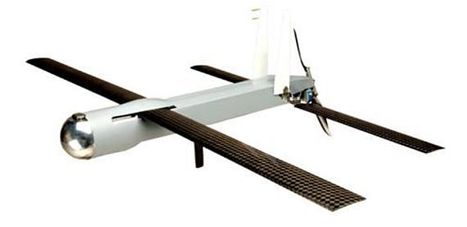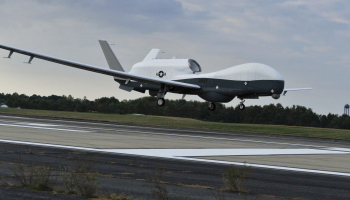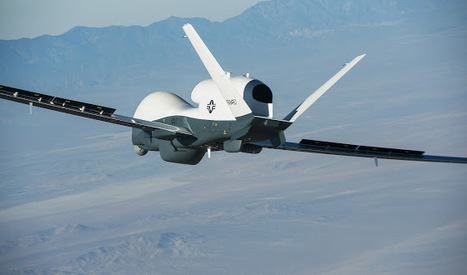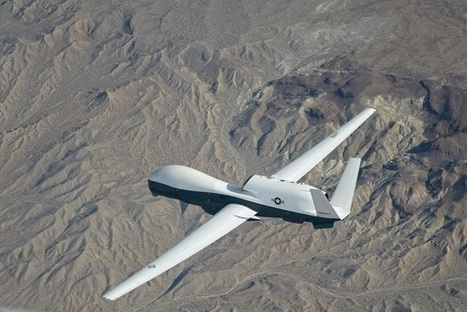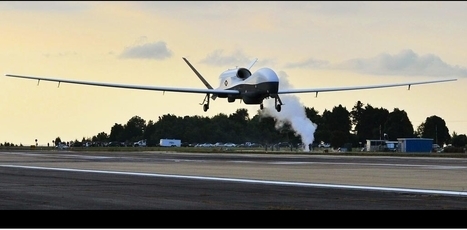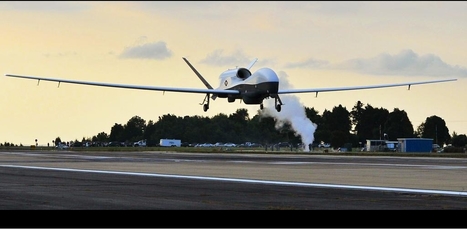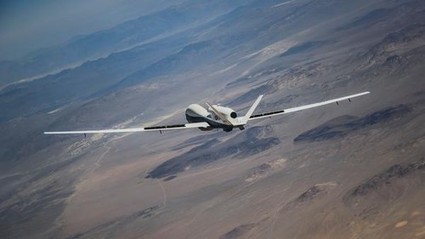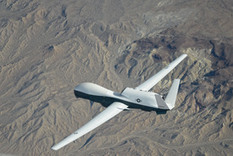 Your new post is loading...

|
Scooped by
Patrick H.
|
ARLINGTON, Va., 2 Feb. 2015.Anti-submarine warfare (ASW) experts at BAE Systems are developing an unmannedaircraft system (UAS) sensor payload able to look for submerged enemy submarines by detecting small variations in the Earth's magnetic field. Officials of the U.S. Office of Naval Research (ONR) in Arlington, Va., announced an $8.9 million contract to the BAE Systems Electronic Systems segment in Merrimack, N.H., for the High Altitude ASW (HAASW) Unmanned Targeting Air System (UTAS) program for the Navy Boeing P-8A Poseidon maritime patrol jet. HAASW UTAS seeks to integrate a magnetic anomaly detector (MAD) and algorithms for use on an air-launched drone that the P-8A will use to detect and pinpoint enemy submarines. A MAD instrument detects minute variations in the Earth's magnetic field. A submerged submarine represents a mass of ferromagnetic material that creates a detectable disturbance in the Earth's magnetic field. The Navy's predecessor to the P-8A -- the Lockheed Martin P-3 Orion four-engine turboprop aircraft -- has a MAD sensor attached to the back that looks like a large stinger that protrudes backward from the plane's tail. ARLINGTON, Va., 2 Feb. 2015. Anti-submarine warfare (ASW) experts at BAE Systems are developing an unmannedaircraft system (UAS) sensor payload able to look for submerged enemy submarines by detecting small variations in the Earth's magnetic field. Officials of the U.S. Office of Naval Research (ONR) in Arlington, Va., announced an $8.9 million contract to the BAE Systems Electronic Systems segment in Merrimack, N.H., for the High Altitude ASW (HAASW) Unmanned Targeting Air System (UTAS) program for the Navy Boeing P-8A Poseidon maritime patrol jet. HAASW UTAS seeks to integrate a magnetic anomaly detector (MAD) and algorithms for use on an air-launched drone that the P-8A will use to detect and pinpoint enemy submarines. A MAD instrument detects minute variations in the Earth's magnetic field. A submerged submarine represents a mass of ferromagnetic material that creates a detectable disturbance in the Earth's magnetic field. The Navy's predecessor to the P-8A -- the Lockheed Martin P-3 Orion four-engine turboprop aircraft -- has a MAD sensor attached to the back that looks like a large stinger that protrudes backward from the plane's tail. These high-altitude torpedoes are Navy Mark 54 lightweight torpedoes with add-n kits that enable the weapons to glide through the air to attack enemy submarines from long ranges and high altitudes. Fixed-wing aircraft like the P-3 normally release conventional torpedoes from very low altitudes or with small parachutes to ease the torpedoes into the water gently. The HAAWC ALA turns the Raytheon Mark 54 torpedo into a glide weapon. As the flying torpedo reaches the water, it jettisons wings and other air-control surfaces and takes on its original role as a smart torpedo that can detect, track, and attack enemy submarines autonomously. The P-8A also is being designed to work together with the Northrop Grumman RQ-4N Triton Broad Area Maritime Surveillance (BAMS) large UAS -- a maritime-patrol version of the Global Hawk long-range surveillance UAS. One or more Triton UAS can detect and track hostile submarines from high or low altitudes, and the P-8A can look for submerged submarines and launch torpedo attacks from high altitudes. The MAD instrument-equipped HAAWC ALA drone will add to the new P-8A's ASW capabilities.

|
Scooped by
Patrick H.
|
The US Navy is launching a competition to provide a new air-to-air radar to help the unmanned Northrop Grumman MQ-4C Triton detect other aircraft and avoid collisions. The solicitation posed by Naval Air Systems Command (NAVAIR) on 3 November comes a year after the Navy canceled development of an Exelis-designed sense and avoid system for the MQ-4C, a high-altitude, long-endurance unmanned air system modeled on the air force’s RQ-4B Global Hawk. The new competition is seeking a radar with less ambitious performance requirements. For example, the navy “expects” that the MQ-4C will receive data from ground radar as it approaches an airport, as air-to-air radars can be confused by ground clutter at lower altitudes. The navy also is taking an incremental approach with the new sense and avoid radar for the MQ-4C. The radar design should be modular and scalable, the navy says, and capable of being improved as future operational and air traffic management requirements evolve. The navy plans to filed the system with a “due regard” capability, a technological step under a full sense and avoid system, the navy says. The navy plans to buy 70 MQ-4Cs, including five prototypes, under an $11 billion programme to monitor the vessels floating on or submerged beneath the world’s oceans and seas. It complements the manned Boeing P-8A Poseidon fleet, and together will replace the Lockheed P-3C Orion as the navy’s aerial look-out for submarines and other naval threats.

|
Scooped by
Patrick H.
|
NAVAL AIR STATION PATUXENT RIVER, Maryland, Sept 23 (Reuters) - I mproved reliability of Northrop Grumman Corp's unmanned MQ-4C Triton spy plane means the U.S. Navy may buy fewer of the drones than the 68 it now has on order, a senior navy official said on Tuesday, a move which may result in lower revenues for the planemaker. The Navy's goal is to have 20 of the huge drones available at any given time to use for five continuous "orbits" of maritime surveillance. It takes four planes to make up one orbit. Rising reliability rates mean the Navy may not need as many of the high-altitude aircraft as first thought, said Captain Jim Hoke, who runs the Triton program for the Navy. Northrop had no immediate comment on the matter. Hoke said he was mindful of tough budget pressures facing the Navy and also had a team looking for other ways to reduce the cost of building and operating the Triton unmanned system. The overall development program is slated to cost about $3 billion, Hoke said. The plane's design was based on the unmanned Global Hawk plane that Northrop builds for the Air Force, but the two planes have only about 20-30 percent in common, Hoke said. The Navy aims to start early operational use of two Triton aircraft by the end of 2017, with the formal "initial operational capability" to follow about six months later when two additional aircraft are delivered. The date slipped due to budget cuts that slowed Northrop's production, Hoke said. Each aircraft now costs about $100 million, but Hoke said the Navy hoped to drive the cost down by finding more efficient ways to build the planes in coming years. Hoke said all new weapons programs were vulnerable during lean budget times, but demand for maritime surveillance remained strong. He said the BAMS-D demonstration aircraft that preceded Triton has been used in the Middle East for six years. The Navy expects to award Northrop a small contract to buy certain components for the first low-production aircraft once the fiscal 2015 budget is approved, Hoke said. He said the number of aircraft in that first batch of orders would be determined as part of the fiscal 2016 budget deliberations. The first of three Triton planes arrived at the base in southern Maryland on Thursday after completing its longest flight ever, a 3,000-mile, 11-hour journey from California. Hoke said two more aircraft would arrive at the base in coming weeks. The planes are due to conduct about 2,000 hours of flight testing before it enters service in 2017. The second plane will have its first flight in California this week, Hoke said. Hoke said he hoped to resume work on an Exelis Inc system that will allow the airplane to "sense and avoid" other aircraft before the end of the year, when he is due to retire. The Navy halted work on the system last year after running into technical issues, and has been working closely with prime contractor Northrop to find a way to fix the problem. Northrop's deputy Triton program manager Tim Kesecker said the company had pulled in experts from other divisions, and he was upbeat that agreement would be reached soon.

|
Scooped by
Patrick H.
|
By Captain Jim Hoke
Triton UAS Program Manager This week, for the first time, we will fly our unmanned MQ-4C Triton cross-country to Naval Air Station Patuxent River, where the “future of naval aviation begins.” For months, our team, comprised of military, civilian and contractor personnel, has been doing a phenomenal job making sure every detail is in place for this historic day. As a program manager, it is an extraordinary opportunity to see the team’s hard work come to fruition. Last year, I had the privilege of watching Triton’s first flight. Since then, I’ve observed tremendous success with our initial envelope expansion flight tests and now I’m anticipating its landing here shortly. For me, my connection to this team and program goes well beyond my three years as program manager. In January 2006, I was serving as the final commodore at Wing FIVE in Brunswick, Maine. During that time, Wing FIVE executed the first-ever operational deployment of the Navy’s Global Hawk Maritime Demonstration Unmanned Aircraft System, now known as BAMS-Demonstrator (BAMS-D). While providing critical information to warfare commanders, BAMS-D also provided critical lessons learned for a future unmanned platform, then named BAMS. At the time, I didn’t anticipate the stake I’d have in the program someday. Now, finally five years later, here I am getting ready for the arrival of that ‘future system’, now formally named Triton. I will be eagerly waiting the MQ-4C take off from Northrop Grumman’s California facility. As it makes its way across the country, flying high at altitudes in excess of 50,000 feet while passing through the southern U.S. border, the Gulf of Mexico, across Florida and up the Atlantic Coast and Chesapeake Bay, we will monitor and control the flight from our Navy System Integration Lab here in Pax River. In the early hours of the morning, our team will watch it land on the runway and taxi into its new hangar for the first time. Triton’s arrival to Pax River marks more than a key milestone on the path to initial operational capability; it represents the tireless work and dedication of a collection of individuals with a common goal in mind: critical capability development and delivery to the warfighter. Teamed with its manned-capability counterpart, the P-8A, Triton will be a key component of the Navy’s family of systems to achieve maritime domain awareness.

|
Scooped by
Patrick H.
|
Twenty UK military personnel are currently working with the US Navy’s Boeing 737-based P-8 maritime surveillance aircraft, with several of these also set to receive training on the service’s remotely-piloted Northrop Grumman MQ-4C Triton, the Ministry of Defence has revealed. Minister for defence personnel, welfare and veterans Anna Soubry says 32 UK personnel are embedded with the maritime patrol aircraft capabilities of Australia, Canada, New Zealand and the USA. Of these, 12 are with units flying variants of the Lockheed P-3 Orion for the air forces of Australia (two), Canada (six) and New Zealand (four). The remainder of the personnel deployed as part of the MoD’s “Seedcorn” initiative are working with P-8 units at NAS Jacksonville in Florida (11) and NAS Patuxent River in Maryland (nine), Soubry says. While UK personnel are retaining key maritime surveillance skills via the multi-year Seedcorn programme, they are also gaining experience in the use of advanced unmanned air systems, Soubry reveals. One officer at the USN’s Patuxent River test site has already been qualified on the Boeing/Insitu RQ-21A Blackjack UAS, while “four are scheduled to train on the MQ-4C Triton during June-August 2014”, she says. Also referred to as the Integrator, the former is a more capable design than the Boeing/Insitu ScanEagle air vehicle now being used by the Royal Navy under an urgent operational requirement deal signed with Boeing Defence UK. Two test examples of the Triton – a development of the high-altitude, long-endurance RQ-4 Global Hawk platform – are due to arrive at the Maryland base within the coming months, with the US service expecting the system to achieve initial operational capability during 2017. Australia in mid-March also confirmed its intention to acquire the MQ-4C to operate alongside its future P-8 aircraft. The question of whether to acquire a replacement UK maritime patrol aircraft capability is likely to be a key part of the nation’s next Strategic Defence and Security Review, which will be conducted in 2015. Soubry was responding to a parliamentary question by Angus Robertson MP, whose Moray constituency includes Kinloss: the former home of the Royal Air Force’s BAE Systems Nimrod MR2 fleet. The last of these were retired four years ago, while the replacement Nimrod MRA4 programme was cancelled in October 2010.

|
Scooped by
Patrick H.
|
The Australian government would spend around 3 billion Australian dollars to purchase seven large unmanned aircraft for the country's border protection, local media reported Saturday. The aircraft would be primarily used for military purposes such as spotting enemy ships and planes in a conflict, but they can also be used to detect asylum seekers since the drone can search an area of 40,000 square nautical miles in a single mission. Defense Minister David Johnston would soon refer to the cabinet for its first pass approval of 3 billion dollars for the seven U.S. made MQ-4C Triton, a maritime version of the Global Hawk.
Johnston also attacked the former Labor government for withdrawing from the unmanned aircraft program in 2009 after spent 100 million dollars in the development of American company Northrop Grumman's Global Hawk drone program.
"I was extremely disappointed," said the minister, quoted by The Australian newspaper.
According to the plan, the seven new drone would be deployed in a air force base close to the southern city of Adelaide and will replace the current aging fleet of P-3 Orion surveillance planes.
|

|
Scooped by
Patrick H.
|
The Indian Navy has earlier shown interest in acquiring six to eight of the maritime variants of the US high altitude, long endurance (HALE) Unmanned Aerial Vehicles (UAV) for extended ocean surveillance. The drones have been upgraded as the MQ-4C Triton maritime surveillance platform for the U.S. Navy, providing real-time intelligence, surveillance and reconnaissance over vast ocean and coastal regions. The Global Hawk has been deployed by the U.S. in Japan, and the U.S. this week approved the sale of four Global Hawks to South Korea. Australia and Japan too have expressed interest in these drones, though Australia later backed out because of the high price. If the deal goes through, it will be a huge force multiplier for the Indian military in carrying out round-the-clock surveillance of terrorist movements across the border or tracking suspicious vessels in the open seas. Apart from the UAVs, both sides are also working to conclude final negotiations of the $2.5 billion helicopter deal for 22 Apache attack helicopters and 15 Chinook heavy lift helicopters, sources said.

|
Scooped by
Patrick H.
|
The US Navy has flown the second Northrop Grumman MQ-4C Triton unmanned aircraft system (UAS), a maritime-focused derivative of the high-altitude, long-endurance RQ-4 Global Hawk. The second aircraft enters the test campaign 17 months after first flight of the original prototype. The first aircraft in September completed a cross-country flight from Northrop’s UAS factory in San Diego to Naval Air Station Patuxent River, Maryland. The second aircraft will now be prepared to complete the same cross-country journey later this month. A third test aircraft is being prepared to complete a first flight in a few weeks. The navy originally planned to fund the third aircraft, but lost the money in budget cuts. Northrop then decided to self-fund production of the third prototype. Data gathered by all three aircraft will be used by the navy to make a decision on whether to launch production in Fiscal 2017. The MQ-4C is based on the RQ-4C but includes a strengthened structure and wing de-icing equipment. It also carries a maritime surveillance payload, which includes a Northrop-built active radar and a receiver tuned to interrogate transponders carried on all commercial vessels. The navy awarded Northrop the $13.5 billion contract to develop and build five test aircraft and 65 production aircraft. The aircraft will serve as an adjunct to the Boeing P-8A Poseidon maritime patrol and anti-submarine warfare aircraft. The MQ-4C is designed to maintain continuous surveillance orbits over maritime areas from five bases spread globally, from Guam to Diego Garcia to Sicily and both the US east and west coasts.

|
Scooped by
Patrick H.
|
PATUXENT RIVER, Md. (NNS) -- The MQ-4C Triton Unmanned Aircraft System (UAS) arrived at Naval Air Station Patuxent River Sept. 18 after completing its inaugural cross-country ferry flight, bringing the Navy closer to delivering this new capability to the fleet.
This flight marked the transition from initial flight test, which established basic safety of flight, to testing that will demonstrate Triton's capability to perform operational missions in the maritime domain.
"Today we brought Triton home to the center of research, development, test and evaluation for naval aviation," said Rear Adm. Mat Winter, who oversees the Program Executive Office for Unmanned Aviation and Strike Weapons (PEO (U&W)) at NAVAIR. "The testing performed here over the next few years is critical to delivering a capability that will provide our warfighter an unparalleled awareness of the maritime environment in locations across the globe."
Winter, along with the flight crew and members from the Triton's Persistent Maritime Unmanned Systems Program Office Office (PMA-262), witnessed the historic landing at 7:53 a.m. During the approximately 11-hour 3,290 nautical mile flight originating from Northrop Grumman's Palmdale, California, facility, the Triton flew along the southern U.S. border, the Gulf of Mexico and across Florida via an approved instrument route. Operators navigated the aircraft up the Atlantic Coast and Chesapeake Bay at altitudes in excess of 50,000 feet to ensure there were no conflicts with civilian air traffic.
"The coordination to bring the Navy's largest unmanned asset across the country was significant and involved many organizations," said Capt. Jim Hoke, PMA-262's program manager. "This phenomenal team executed the system's longest flight to date exactly as planned."
Hoke said this perfect execution was no surprise to him since the system has exceeded performance standards during the course of the last year. Triton has completed 15 test flights prior to today's ferry flight, demonstrating its ability to operate at various speeds and altitudes.

|
Scooped by
Patrick H.
|
The cost to develop Northrop Grumman Corp. (NOC:US)’s reconnaissance drone for the U.S. Navy has increased by at least 25 percent, or $720 million, according to Navy estimates and congressional investigators. As development costs have risen to at least $3.9 billion, the scheduled dates to begin production and then deployment of the Triton drone have each slipped by more than two years, according to a Senate committee. The Senate Appropriations Committee said in its report on funding defense programs in fiscal 2015 that it “is concerned with the cost and schedule breaches over the past few years” and is “troubled by software development delays” for the 70-aircraft, $15.3 billion program. That’s at odds with the assessment of Wes Bush, chairman and chief executive officer for Falls Church, Virginia-based Northrop. He told analysts on an earnings conference call last week that the drone program “is moving along very well.” The MQ-4 Triton is based on Northrop’s Global Hawk unmanned aircraft. The new drone is designed to work in tandem with Boeing Co. (BA:US)’s P-8A manned maritime patrol aircraft to survey 360-degree swaths of ocean and terrain with radar and electro-optical and infrared sensors. It can fly 24-hour missions as high as 60,000 feet, with a maximum range of 9,950 nautical miles without refueling. “Contract cost growth was associated with technical challenges associated with system integration and developmental testing prior to first flight in 2013,” Sean Burke, the Triton program’s deputy manager, said in an e-mailed statement. All of those issues have been resolved, he said. Delays Outlined The projected start of initial production has been delayed by 31 months to December 2015 from the original goal of May 2013. The target date to declare an initial squadron of the drones ready for combat has slipped to April 2018 from December 2015, according to Navy documents. The projected start of full-rate production -- the most lucrative phase for a contractor -- has slipped to January 2018 from December 2015. Citing the delays and cost increases, the Senate appropriations panel blocked the Navy’s $37.4 million fiscal 2015 request for the early purchase of production parts and cut $60 million from the service’s $498 million research request. “Northrop Grumman and the Navy are developing the world’s most sophisticated unmanned, broad-area maritime surveillance capability,” Randy Belote, a company spokesman, said in an e-mailed statement. “Before Triton enters its production phase, we are committed to ensuring that it meets or exceeds its performance requirements through a rigorous development phase. We are confident that the Triton program will enter” its initial production phase in 2016. Navy Budgets Continued delays and cost increases could subject the program to reductions or cancellation as the Navy struggles to pay for new classes of vessels, a replacement for the Ohio-class nuclear missile submarine program and its model of the F-35 fighter, all in a time of declining defense spending. So far, the drone program’s setbacks haven’t triggered a notification to Congress that the program has exceeded cost thresholds established by the 1982 Nunn-McCurdy law, which submits a program to an intensive scrutiny and certification process to explain why it shouldn’t be canceled. Burke said the Navy won’t discuss what financial penalties Northrop is incurring under its “cost-plus incentive fee” contract, such as lost or withheld dollars, because of the delays.

|
Scooped by
Patrick H.
|
The Navy's MQ-4C Triton completed its initial flight test phase at Northrop Grumman's Palmdale, Calif., facility March 13, bringing the unmanned air system one step closer to introduction to the fleet in 2017. The flight testing, called Initial Envelope Expansion, is designed to measure the air vehicle’s performance under a variety of speeds and altitudes. The combined Navy and Northrop Grumman team completed this phase of testing in 13 of the 14 scheduled flights for the test. "The system performed exceptionally well during flight test, which is a reflection of years of hard work and dedication by our team," said Capt. Jim Hoke, Triton UAS program manager. "Our job is far from over with fleet delivery still a few years away, but each of our team members should reflect on how far we have come and be proud of this accomplishment." During IEE, the MQ-4C flew a total of 81 hours, reached a maximum altitude of 59,950 feet and executed 568 data points. The Triton’s software and sensor systems are being tested separately on a surrogate aircraft. This includes a multi-function array sensor (MFAS), configured to function in a maritime environment. After testing completion at Palmdale, the team has a planned maintenance period to prepare for the system's transition to Naval Air Station Patuxent River. The MQ-4C will take its first cross-country flight in the June/July timeframe, followed by the second test aircraft shortly after. Sensors will be integrated onto both aircraft before resuming flight test this summer. As an adjunct to the manned P-8A aircraft, the Triton will cover more than 2.7 million square miles in a single mission. Its ability to perform 24/7 intelligence, surveillance and reconnaissance with a range of 2,000 nautical miles will allow P-8A, P-3C and EP-3E aircraft to focus on their core missions, adding the capability the Navy's Maritime Patrol and Reconnaissance Force.

|
Scooped by
Patrick H.
|
San Diego January 6, 2014 – Northrop Grumman Corporation and the U.S. Navy have completed nine initial flight tests of the Triton unmanned aircraft system (UAS), marking the half-way point in a process called envelope expansion.
During envelope expansion, the test team validates the aircraft's ability to operate at a range of altitudes, speeds and weights. The flights are taking place at the company's manufacturing facility in Palmdale, Calif.
"Completion of envelope expansion will allow the test team to prepare for installation and further testing of Triton's surveillance sensors," said Mike Mackey, Northrop Grumman's Triton program director.
The Triton test team accomplished endurance flights up to 9.4-hours at altitudes up to 50,000 feet. The aircraft also performed doublets, a maneuver that tests the aircraft's ability to recover from small perturbations in its flight path caused by turbulence.
Triton carries a variety of intelligence, surveillance and reconnaissance sensor payloads that allow military commanders to gather high-resolution imagery, use radar to detect targets, and provide airborne communications and information-sharing capabilities to military units across long distances.
The Navy plans to field 68 Triton UAS and will be used with the manned P-8 Poseidon maritime patrol aircraft to conduct surveillance missions.
Triton completed its first flight May 22.
|



 Your new post is loading...
Your new post is loading...

